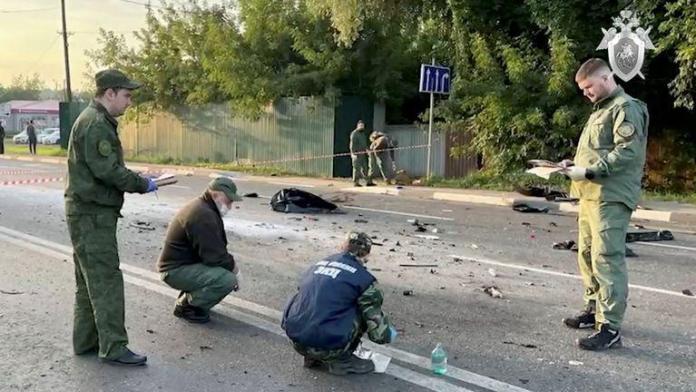By Jeremy Kuzmarov
Douglas Valentine says that “Zelensky doesn’t go to the bathroom without asking permission from his CIA case officer.”
CIA expert Douglas Valentine, author of the seminal book The Phoenix Program (1990), believes that the CIA was behind the car bomb that killed Darya Dugina, a journalist and daughter of well-known Russian intellectual Alexander Dugin.
Ms. Dugina, 29, was killed on Saturday night when a bomb blew up the Toyota Land Cruiser she was driving in a suburb of Moscow. She was the intended target along with her father, whose promotion of a Eurasian Union has influenced the thinking of Vladimir Putin and members of his inner circle.
Russia’s Federal Security Services (FSB) blamed the Ukrainian intelligence services for the killing, specifying that the attack was carried out by a woman named Natalya Vovk (AKA Natalya Shaban), a member of the Azov Battalion along with her brother who arrived in Russia last month with her teenage daughter.[1]
Vovk allegedly rented an apartment from where she researched Ms. Dugina, attended “The Tradition” celebration where her father gave a speech and Ms. Dugina was killed, and after planting the bomb, fled to Estonia via Pskov.

According to Douglas Valentine, “Zelensky doesn’t go to the bathroom without asking permission from his CIA case officer. Ten billion dollars comes with a lot of strings attached. The CIA would have been intimately involved in recruiting the woman assassin, preparing the plan every step of the way including escape. That’s just Standard Operating Procedure.”
Valentine admits of course that there is no direct evidence to implicate the CIA in Dugina’s killing and that he’s making an “educated guess,” however, “clandestine ops occur by definition without anyone knowing they happened.” Valentine further told CAM that “the CIA doesn’t conduct a covert operation of this grandiosity unless it’s deniable and worth the risk. That’s known. So there’s rarely any evidence.”
Phoenix Program Redux
Just days before Dugina’s assassination, The New York Times published a front-page article about Ukrainian guerrilla fighters, or partisans, who openly admitted to planting car bombs targeting pro-Russian police officers and politicians behind Russian lines.
Ukraine’s Special Services (SBU) is also known to have set up a Phoenix-style kidnapping and assassination program targeting dissidents, including mayors and local government officials considered sympathetic to Russia.
Vasily Prozorov, a former SBU officer, meanwhile proclaimed that the SBU had been advised by the CIA since 2014. “CIA employees [who have been present in Kyiv since 2014] are residing in clandestine apartments and suburban houses,” he said. “However, they frequently come to the SBU’s central office for holding, for example, specific meetings or plotting secret operations.”
Valentine told CAM in April that the CIA “is applying the same organizational structure in Ukraine as it used in South Vietnam to conduct an updated version of the typical ‘two tier’ Phoenix program. The top tier is to assure political control, the lower tier to pacify the population.”
Valentine continued:
“CIA foreign intelligence officers advise SBU security service to assure ‘top tier’ internal security and political control; and Ukrainian CIA agents run ops into Donbas, Russia and Belarus, sending illegal travelers, smugglers, and agents to set up agent nets and penetrate the enemy in his territory, [and carry out] sabotage and subversion. SBU and Ukrainian CIA are where hit-lists get authored. CIA officers advise military, militias and mercenaries in deniable political, paramilitary and psychological operations to terrorize and otherwise persuade civilian population to support Zelensky while demoralizing and fighting the enemy.”
As in Vietnam, some of the CIA agents may be operating under the cover of State Department-run police training programs which were instituted in Ukraine after the 2014 Maidan coup.[4] Others have been assigned to specialized paramilitary units fighting in eastern Ukraine.[5]
Valentine stated that the “original Phoenix was responsible for the planned assassination of between 25,000 to 40,000 people in South Vietnam. Based on the Phoenix organizational model, assassination became a standarized component of military and CIA operations. It has since been perfected, as evidenced by the assassination of Dugina and scores of other examples from Central Americca to Iran to Africa and the Far East.”
The CIA, Valentine added, is “always finding a reason to start a war, so they can send the next generation of young men into battle, to learn how to kill people in the most brutal fashion—that’s Phoenix, always rising from the ashes of war.”
- A Russian website of the NemeZida project, which publishes data on Ukrainian servicemen posted in April that Natalya Shaban, born in 1979, served in the Azov-based National Guard. (The National Guard is not the same as the U.S. National Guard; rather, it was formed directly by the hardcore Azov Regiment, with many members not directly members of the Azov.) The April posting displays a copy of Vovk/Shaban’s certificate indicating military unit No. 3057, in which the 12th brigade of the National Guard of Ukraine is stationed. Shaban is the name that her daughter, Sophia Shaban, used when they entered Russia—and the assumption is that Natalya Vovk is the maiden name of Natalya Shaban. The photograph of the National Guard member is a close match with the Natalya Vovk renting an apartment next to Darya Dugina’s residence. ↑
We remind our readers that publication of articles on our site does not mean that we agree with what is written. Our policy is to publish anything which we consider of interest, so as to assist our readers in forming their opinions. Sometimes we even publish articles with which we totally disagree, since we believe it is important for our readers to be informed on as wide a spectrum of views as possible.











